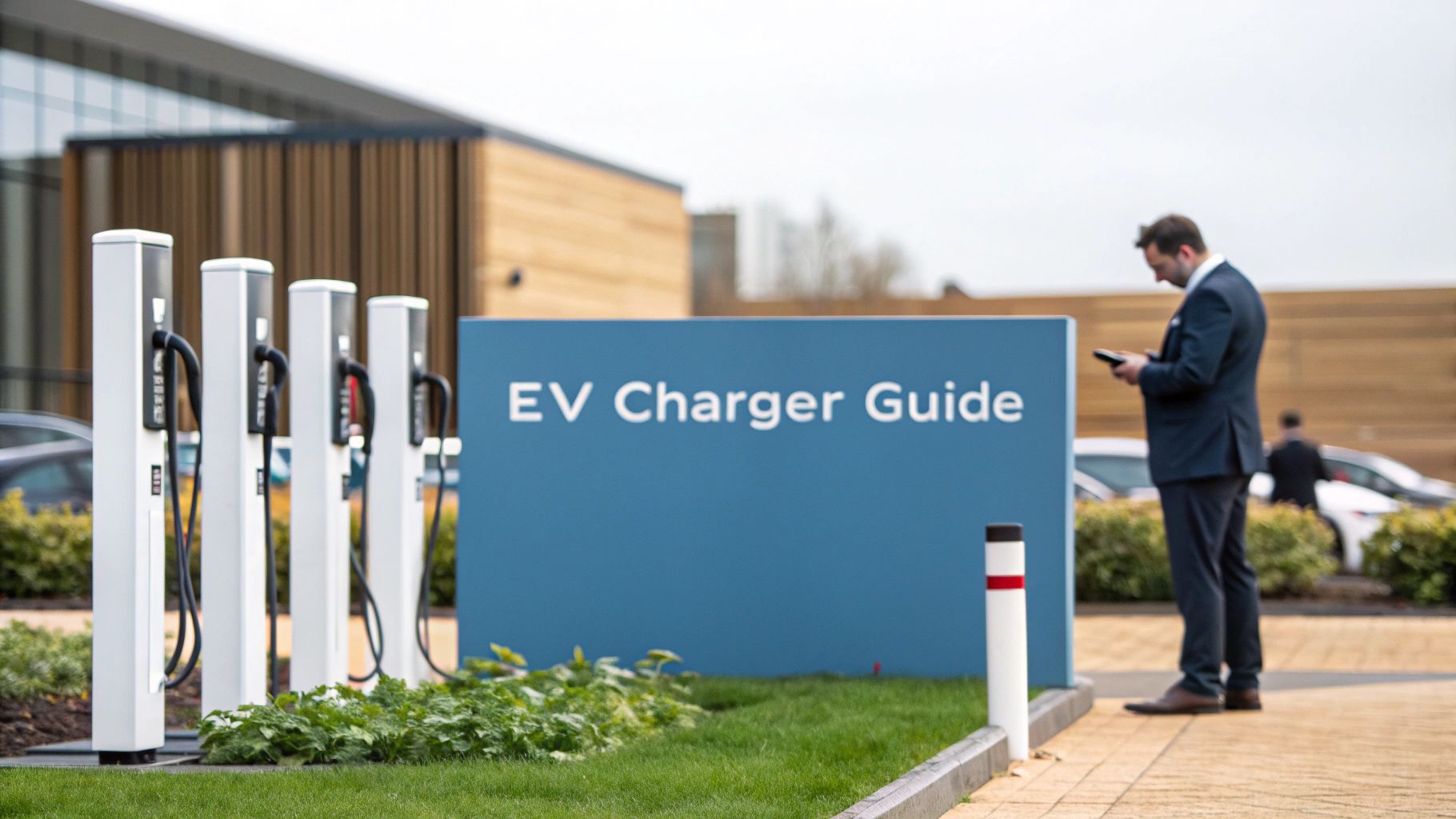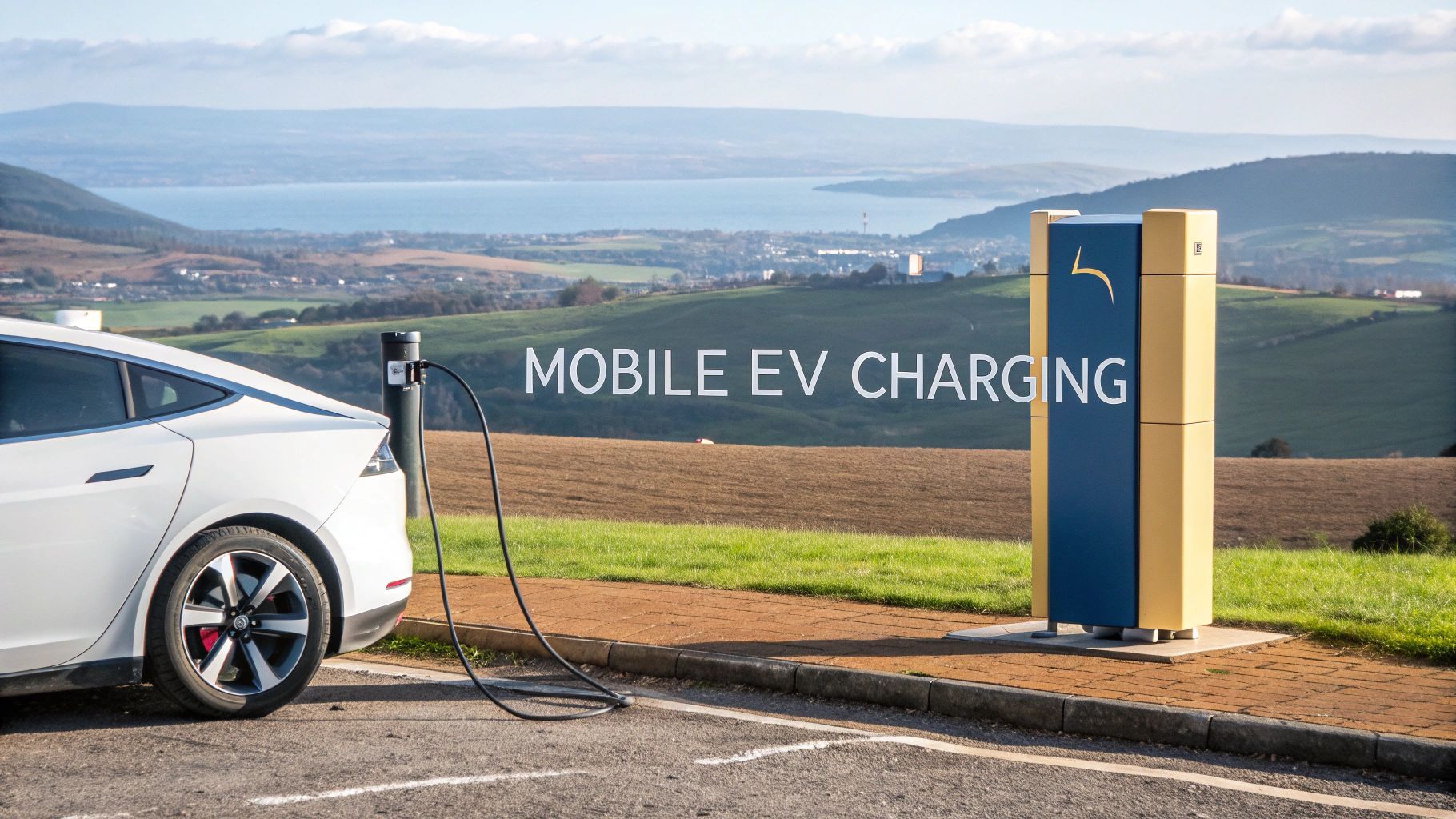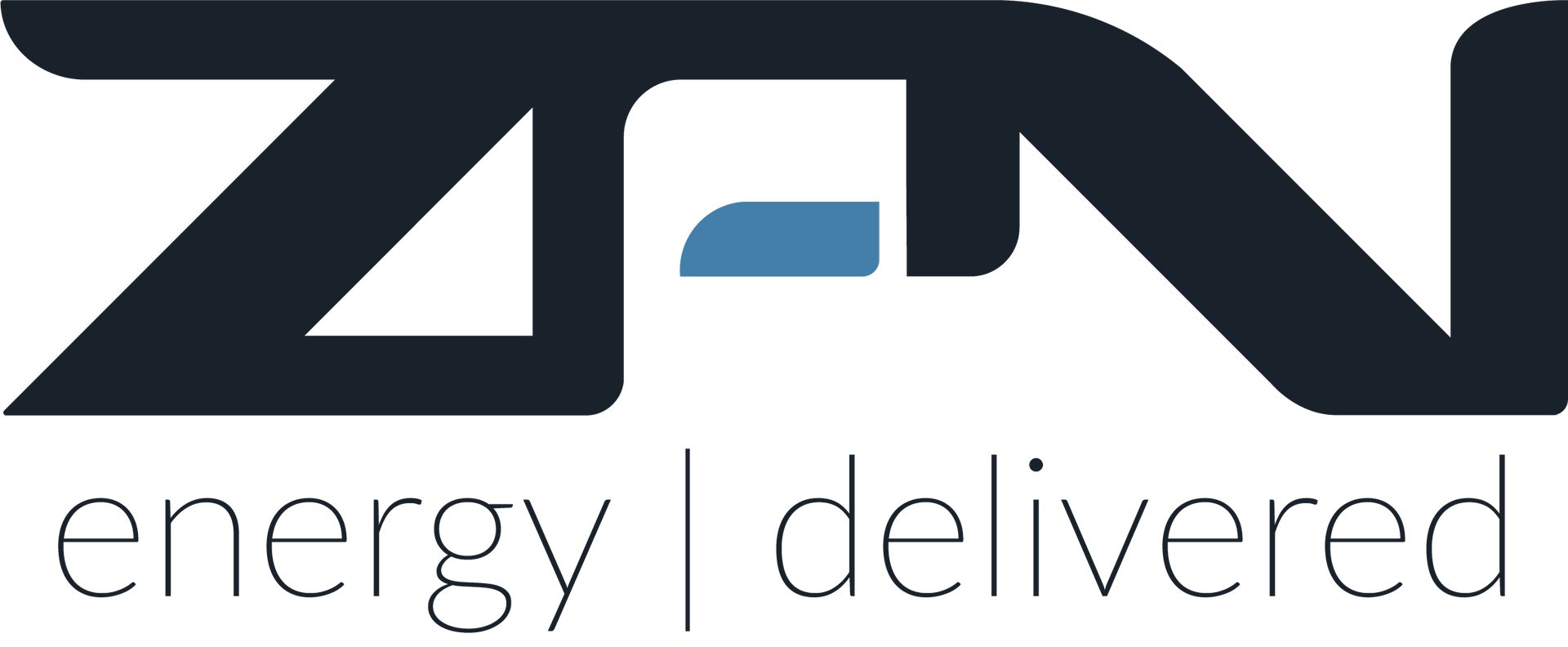UK Guide to Siemens Replacement Parts for EV Charging
When you're responsible for advanced energy systems, sourcing the right Siemens replacement parts is not just a maintenance task—it is the best way to protect your investment. Using genuine, authentic components guarantees perfect compatibility, keeping everything from rapid EV chargers to grid-scale batteries operating safely and efficiently. This guide will walk you through exactly why this matters for your UK-based EV charging network.
Why Genuine Siemens Parts Are Crucial for Your Energy Infrastructure
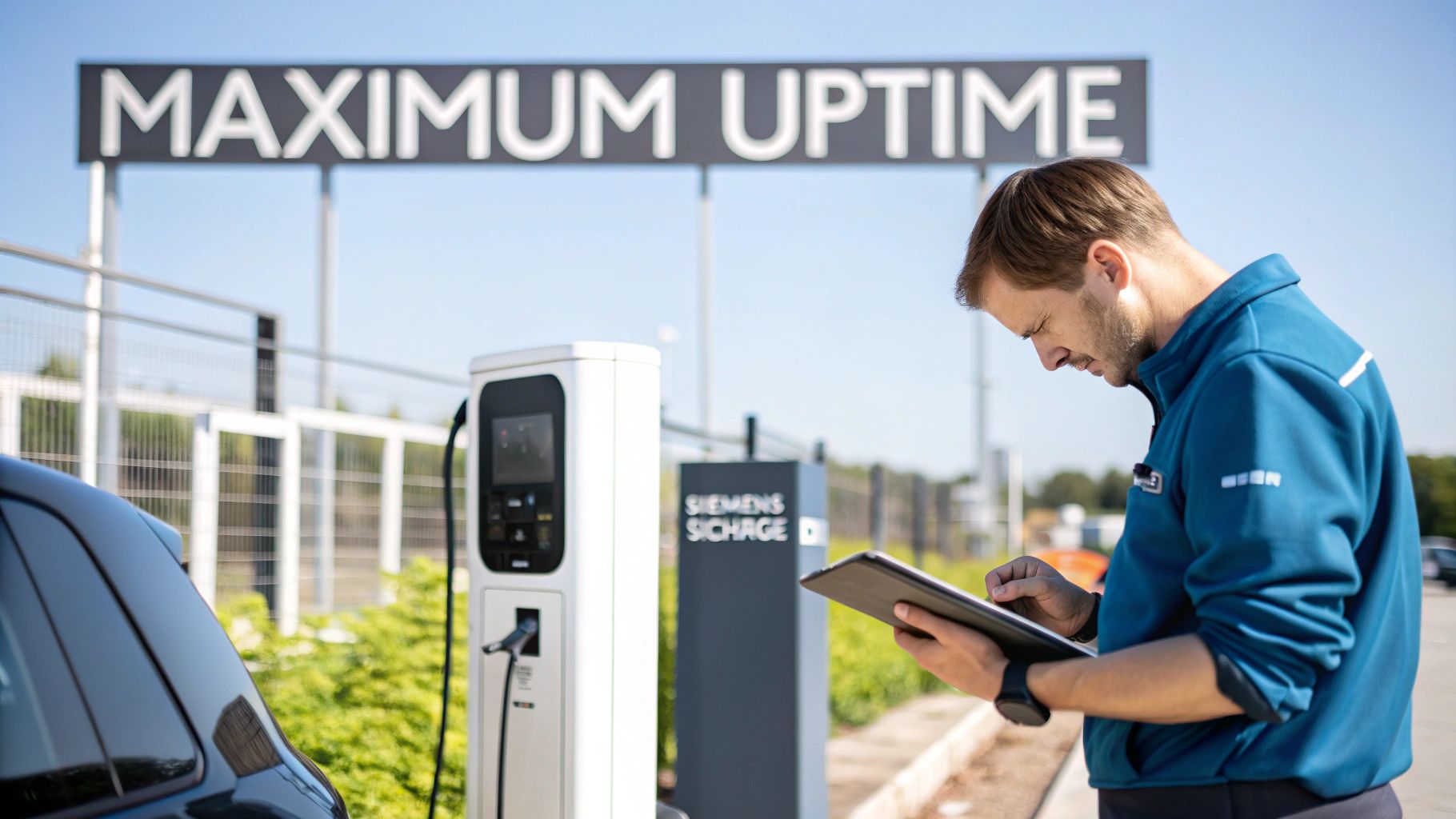
In the world of modern energy management, every component has a critical job to do. Think about a busy rapid EV charging hub with high daily use or a grid-scale battery balancing a fluctuating supply from renewables. In these scenarios, system reliability is everything.
The temptation to cut costs with cheaper, non-genuine parts is understandable but it’s a gamble that rarely pays off. Doing so introduces significant risks that can lead to expensive downtime, serious safety hazards and could even void your system's warranty.
Genuine Siemens replacement parts are engineered to the exact specifications of the original equipment. This means you’re not just getting a perfect fit; you're getting the precise electrical and thermal performance needed for high-demand applications.
Think of your SICHARGE D rapid charger as a finely tuned machine. Using an aftermarket contactor is like putting the wrong type of oil in a high-performance engine. It might seem to work for a while but you’re setting it up for almost certain failure down the line.
The Impact on Advanced Systems
The stakes get even higher with more sophisticated setups. For instance, charging systems designed to work with constrained grid connections depend on precise control modules to balance the load and prevent network overloads. A non-genuine part might not have the required response time or resilience, leading to system trips or worse, permanent damage.
It's a similar story for distributed energy networks that combine on-site renewables with battery storage. Every component must communicate flawlessly to keep the system stable. Using authentic Siemens parts is the only way to be sure that seamless integration is maintained.
Using authentic parts isn’t just about making a repair; it’s a strategic investment in the longevity, safety and efficiency of your entire energy asset. It protects your initial outlay and ensures your infrastructure can handle the evolving demands of the UK's energy transition.
Properly maintaining these systems is a continuous process. For a deeper dive into the entire lifecycle, our complete guide to UK EV charger servicing offers valuable insights into best practices for ongoing upkeep.
Genuine Siemens Parts vs Aftermarket Alternatives
It's easy to see why some might consider aftermarket parts but when you look closer, the value proposition of genuine components becomes clear. Here’s a quick breakdown of what you’re really choosing between.
| Attribute | Genuine Siemens Parts | Non-Genuine Alternatives |
|---|---|---|
| Compatibility | Guaranteed perfect fit and function, designed for your specific system. | May require modifications or workarounds, leading to poor performance. |
| Performance | Meets exact electrical, thermal and mechanical specifications. | Performance is often inconsistent and can degrade quickly under load. |
| Quality & Safety | Undergoes rigorous testing and meets strict safety standards. | Quality control is often minimal or non-existent, posing safety risks. |
| Warranty | Maintains your original equipment warranty. | Use often voids the manufacturer's warranty on the entire system. |
| Longevity | Built to last, ensuring a long and reliable service life. | Prone to premature failure, leading to more frequent replacements and downtime. |
| Support | Backed by Siemens' technical support and expertise. | Little to no technical support available, leaving you on your own. |
Ultimately, the short-term savings from an aftermarket part are quickly erased by the long-term costs of downtime, repeat repairs and potential system damage.
Choosing genuine parts gives you peace of mind. You know the component has been through rigorous quality control and is backed by Siemens' world-class engineering. This is especially vital for:
- Rapid and Mobile EV Charging: Where uptime has a direct impact on revenue and customer satisfaction.
- Grid-Scale Batteries: Where reliability is non-negotiable for grid stability and energy security.
- Integrated Renewable Systems: Where a single component failure can disrupt the entire on-site energy ecosystem.
By committing to genuine Siemens parts, you’re safeguarding your operations against unexpected failures and ensuring your infrastructure remains a reliable, profitable asset for years to come.
How to Pinpoint the Exact Siemens Part You Need
Getting your hands on the right Siemens replacement part for an EV charger or energy storage system can feel a bit like finding a needle in a haystack. With complex kit like a SICHARGE D rapid charger or a grid-scale battery control panel, even a single wrong digit in a part number can mean ordering an incompatible component. That leads to delays, extra costs and a whole lot of frustration.
The secret is knowing exactly where to look and how to read the information staring back at you.
It all starts with a hands-on inspection of the equipment itself. Siemens is meticulous about labelling every critical component for traceability. Your mission is to find the Article Number , also known as the MLFB (a German acronym for Maschinenlesbare Produktbezeichnung ). This is the definitive identifier for any Siemens product and it's your key to getting the right part, first time.
Locating Part Numbers on Your Equipment
Where you find this number really depends on the system you're working with. For the big installations, you'll likely need to open an access panel or pull out a specific module to get a clear view. It goes without saying but always make sure the system is safely powered down and locked out before you go poking around.
Here are a few common places to start your search:
- SICHARGE D Rapid Chargers: Check for identification plates on the individual power modules, contactors and control circuit boards. They’re often small silver or white labels with the Siemens logo, QR codes and a string of numbers.
- Mobile EV Charging Units: Things are packed in tight here. You’ll probably find labels on the main control unit, the charging cable assembly connector and any internal power conversion modules.
- Grid-Scale Battery (BESS) Control Panels: For these larger systems, part numbers are usually found on the primary control modules, circuit breakers and interface cards inside the main cabinet. Every card or module will have its own unique identifier.
Let’s say you’re replacing a faulty contactor in a rapid charger. The Article Number will likely be printed clearly on the side of the component's housing. A specific BESS control module will have its own label, which is totally different from the serial number of the entire cabinet.
Using the Siemens Industry Mall for Verification
Once you’ve got the Article Number, your next stop is the official Siemens Industry Mall . This online catalogue is the most reliable place to verify you’ve got the right information and to pull up detailed technical specs. Honestly, it’s an essential tool for confirming compatibility before you spend a penny.
Here's the main portal for the UK version of the Siemens Industry Mall, where you can kick off your search.
Just pop the Article Number you found into the search bar at the top. This will take you straight to a product page breaking down the part's specifications, dimensions and its lifecycle status—confirming if it’s current or has been superseded by a newer model.
Pro Tip: Keep an eye out for revision codes or firmware versions listed next to the part number. For control modules, a tiny difference in firmware can throw a spanner in the works, affecting compatibility with the rest of your system. This is especially true for interconnected distributed energy networks.
Deciphering Model Numbers and Common Failure Points
Getting a feel for the structure of Siemens model numbers can give you an extra layer of confidence. They might look complex but they often contain codes that tell you the product family, voltage rating and specific features. This bit of knowledge helps you spot a potential mismatch before it becomes a problem. For a deeper dive into how these components fit into the bigger picture, check out our guide on Siemens energy meters for EV charging grid management.
From experience, you also learn that certain parts in high-use environments are just more likely to wear out. Spotting these weak links proactively can save you a massive amount of downtime.
Common Failure Points to Monitor:
- Contactors and Relays: In rapid chargers, these mechanical switches handle huge currents and can wear out after thousands of charging cycles.
- Cooling Fans: They’re essential for keeping temperatures in check in both chargers and battery systems. When they fail, it can lead to overheating and automatic shutdowns.
- User Interface Screens and Buttons: On public-facing chargers, these parts take a beating from constant use and, unfortunately, occasional vandalism.
- Power Supply Units: The internal power supplies that run the control electronics are a frequent point of failure in any advanced electrical system.
By methodically finding the Article Number on the physical part and then cross-referencing it in the Siemens Industry Mall, you take all the guesswork out of the process. It's the surest way to order the exact Siemens replacement parts you need to keep your EV charging and energy infrastructure running smoothly and reliably.
Sourcing and Ordering Genuine Siemens Parts in the UK
Once you've got the right part number, the real work begins: getting your hands on the genuine component from a trusted source. For anyone running EV charging hubs or distributed energy networks in the UK, this means sticking to official channels to guarantee you’re fitting authentic Siemens replacement parts . It's a non-negotiable step for protecting your investment and the long-term health of your systems.
You essentially have two main routes for buying authentic parts: ordering directly from Siemens or working with their network of authorised UK distributors. Both paths get you the same high-quality components but they serve different needs. Direct orders often make sense for huge enterprises with established accounts, while authorised distributors provide local support, stock and expertise. That local knowledge can be a lifesaver when you need a common part, fast.
Verifying Your Supplier and Avoiding the Grey Market
You have to be incredibly careful of the grey market. Unofficial sellers might dangle a lower price tag but it almost always comes with a catch. These parts could be counterfeit, refurbished but passed off as new or just old stock that's well past its prime. Sticking one of these in a high-demand SICHARGE D rapid charger or a grid-scale battery system is asking for trouble—it can lead to immediate failure and put the safety of your entire setup at risk.
Before you even think about placing an order, check your supplier's credentials. An authorised distributor will be listed on the Siemens UK website and should have no problem proving their partnership. This one simple check is your best defence against dodgy parts.
A genuine part’s upfront cost is an investment in reliability. The long-term value delivered through guaranteed performance, warranty protection and system integrity far outweighs any initial savings from a non-verified supplier.
This quick infographic breaks down the process for getting the right part, every time.
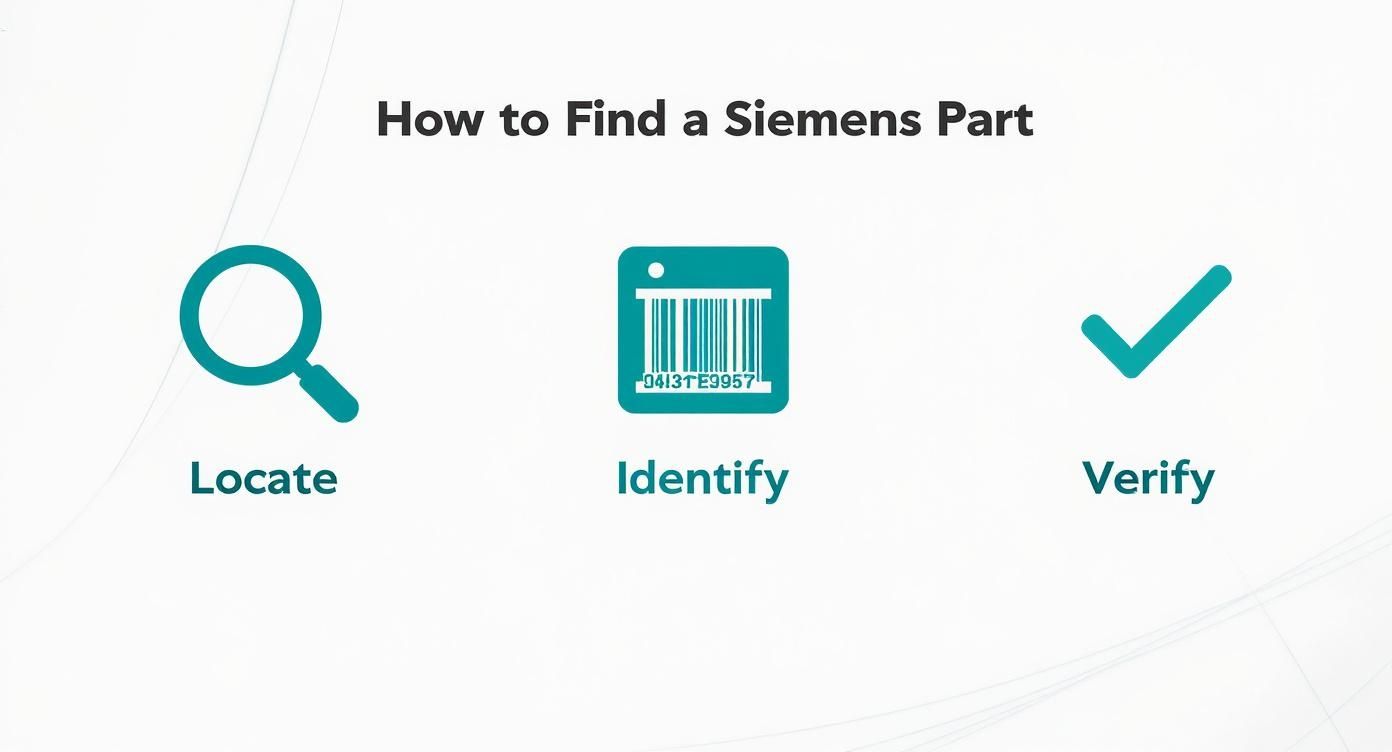
This simple workflow—locate the physical component, identify its unique number and verify it with an official source—takes the guesswork out of the equation and stops costly ordering mistakes before they happen.
Understanding Total Cost of Ownership
When you’re managing critical infrastructure, purchasing decisions have to be about the total cost of ownership (TCO), not just the sticker price. For assets like EV charging from constrained grid connections or mobile EV charging fleets, TCO isn't just the cost of the part. It also includes the potential fallout from a bad one:
- Downtime: Every hour a rapid charger is offline is revenue you'll never get back.
- Labour: The cost of sending engineers out for repeat repairs because of a cheap part failing early adds up fast.
- System Damage: An incompatible component can set off a chain reaction, damaging other parts of the system.
- Warranty Invalidation: Using non-genuine parts is one of the fastest ways to void the warranty on your entire system.
Genuine parts are engineered for performance and a long service life, making sure you get the most out of your equipment. As you get deeper into sourcing Siemens components, it’s worth reviewing some general Siemens brand information to get a better sense of their commitment to quality.
Insider Tips for Managing Large Network Orders
If you’re managing a large network of EV chargers or distributed energy assets, you need a more strategic approach to procurement. Think about consolidating your orders for common failure items like filters, fans and contactors. This can help you negotiate better pricing and ensures you have critical spares on hand when you need them.
Building a solid relationship with a dedicated account manager at an authorised distributor is also a game-changer. They can give you the inside track on lead times, let you know about upcoming part revisions and help you forecast your inventory needs. It also helps to understand the wider market; for more context on the key players, take a look at our overview of the leading UK EV charging station manufacturers you should know.
At the end of the day, a methodical, verified procurement process is the best insurance you can have for the health and performance of your valuable energy assets.
Modernising Your System with Strategic Part Upgrades

When a critical component gives out in your EV charging network or energy storage system, the first thought is always to get it back online. Fast. But that moment of failure is more than just a problem to be solved; it's a chance to modernise.
By choosing the right Siemens replacement parts , you can shift from a reactive fix to a proactive upgrade. It’s an opportunity to boost performance, improve efficiency and get your system ready for what's next. Instead of just a like-for-like replacement, think about whether a newer, more advanced component could do the job better. You're turning a simple maintenance task into a genuine system enhancement.
This forward-thinking approach is already taking hold across UK industries. Research from Siemens Financial Services (SFS) found that 75% of UK machine builders now offer retrofit modernisations. It's becoming a key part of the sustainability conversation, helping businesses move towards a circular economy. You can dive deeper into the full research on the growing market for machine retrofits here.
Real-World Retrofit Scenarios
Imagine an older rapid EV charging station that's starting to show its age. When a power module fails, it's the perfect time to install a newer, more efficient model. That single change could increase charging speeds or improve thermal management, reducing the risk of overheating during peak times.
Or think about a business running EV charging points from a constrained grid connection. A small component failure could be the catalyst to install a more intelligent control module. This simple upgrade might introduce smart load-balancing, letting you serve more vehicles without the headache and expense of a grid capacity upgrade.
A necessary repair is the ideal moment to assess your system’s long-term viability. By strategically upgrading with modern Siemens components, you are not just fixing today’s problem—you are investing in tomorrow’s performance and compliance.
Upgrading for Evolving Standards and Performance
The energy landscape never stands still. New standards for grid compliance, interoperability and safety are always emerging. Using a replacement as an upgrade opportunity ensures your assets stay compliant and competitive.
Let's look at a few practical examples where a strategic part upgrade really pays off:
- Grid-Scale Batteries: Swapping an older inverter for a new Siemens model can dramatically improve round-trip efficiency. That means less energy is lost during charging and discharging, which directly impacts the profitability of your battery energy storage system (BESS).
- Combined On-site Renewables: If a communication module in your system fails, replacing it with a next-generation part can unlock faster response times. This allows for better coordination between your solar panels, battery storage and EV chargers, creating a more stable and efficient microgrid.
- Mobile EV Charging Units: Upgrading the internal power electronics in a mobile charger can make it more resilient to voltage fluctuations—a vital improvement for units deployed in various locations with unpredictable grid quality.
Making Modernisation Financially Accessible
Of course, the upfront cost of a modern component can be higher than a direct replacement. But flexible financing options are now widely available to make these strategic modernisations more accessible for UK businesses. These solutions can spread the cost over time, so you can start benefiting from the improved performance and efficiency right away.
This approach turns an unexpected capital expense into a manageable operating cost. When you frame the upgrade as a long-term investment that delivers tangible returns—through energy savings, increased uptime or enhanced capacity—the business case becomes clear. It’s a proactive strategy that aligns perfectly with the UK’s drive towards a more sustainable and circular economy.
A Practical Guide to Installing Key EV Charger Components
Swapping out a component in your EV charging system is about much more than just having the right part on hand. It demands a serious, methodical approach to safety and procedure.
While the really complex electrical work must always be left to a certified technician, there are a number of user-serviceable Siemens replacement parts that can be installed by your own trained on-site personnel. This guide walks you through the framework for those jobs, with safety as the absolute top priority.
We'll focus on the hands-on steps for installing common parts like filters, contactors and certain control modules. The principles here are universal but remember: you must always consult the official Siemens technical documentation for your specific model before you even think about starting.
Pre-Installation Safety: The Absolute Priority
Before you open a single panel or touch any component, a full safety check is non-negotiable. These systems, especially rapid EV chargers and grid-scale batteries, are running at incredibly high voltages. Cutting corners on safety protocols can lead to severe injury or far worse.
The absolute cornerstone of safe electrical work is the lock-out/tag-out (LOTO) procedure. This isn't just a suggestion; it's a formal process that guarantees a machine is completely de-energised and can't be accidentally powered up while someone is working on it. Every single person on your team needs to be thoroughly trained on this.
Your pre-installation checklist must cover:
- Complete De-energisation: Confirm every power source to the unit is disconnected. That means the AC mains, any DC links from batteries and all auxiliary power feeds.
- Verification: Use a calibrated multimeter to test for zero voltage right at the connection points where you'll be working. Never, ever trust indicator lights alone.
- Lock-Out/Tag-Out Application: Physically lock the main isolator switches in the "off" position. Then, attach a tag with your name, the date and a clear warning not to operate the equipment.
- Personal Protective Equipment (PPE): At a minimum, wear insulated gloves rated for the system's voltage, safety glasses and flame-retardant clothing. And it should go without saying but never wear any metallic jewellery.
A Walkthrough: Replacing a Power Module
Let's put this into a real-world context. Imagine you're replacing a faulty power module in a SICHARGE D rapid charging unit. These modules often bear the brunt of high thermal and electrical stress, making them a common failure point.
First things first, after carrying out the full LOTO procedure, you'll open the main access panel to find the faulty module, which is usually slotted into a rack system. You'll see several connections: a primary power connector, various control signal harnesses and potentially liquid cooling lines.
Get your tools ready—you'll need properly insulated screwdrivers and socket wrenches. I always start by carefully disconnecting the control harnesses, making a note of where each one goes. Next, undo the primary power connections. These are hefty cables, so handle them with care. Finally, if it has them, disconnect the cooling lines and be prepared for a little bit of fluid spillage.
A quick pro tip: Always handle new electronic components carefully to avoid static damage. Hold the modules by their metal casing or edges and keep your fingers away from the circuit board and connector pins.
With the old module out, installation is simply the reverse of removal. Slide the new Siemens replacement part into the rack and make sure it's seated securely. Reconnect the power cables, tightening all bolts to the manufacturer’s specified torque settings. Finally, reattach the control harnesses and cooling lines.
Post-Installation System Checks
Just because the new part is in and the panels are back on, doesn't mean the job is done. Now you need to run a series of post-installation tests to confirm the repair was a success and the system is safe to bring back online.
Start by removing your LOTO device and restoring power, following the sequence laid out in the service manual. The system will likely run a self-test or boot-up sequence. Keep a close eye on the control panel for any error codes or fault messages.
A proper post-installation check should include:
- Visual Inspection: As soon as the power comes on, look and listen for any signs of arcing, smoke or unusual noises.
- System Diagnostics: Jump into the charger's service menu to check the status of the new component. The system should recognise the new power module and report it as fully operational.
- Functional Test: Run a test charging session, either with a vehicle or a dedicated EV simulator. You'll want to monitor charging parameters like voltage, current and power output to ensure they're stable and within the expected range.
- Thermal Monitoring: While the test charge is running, use a thermal camera if you have one to check the temperature of the new part and its connections. A hotspot could signal a poor connection that you need to fix immediately.
Only when the system has passed every one of these checks can it be officially returned to service. Following this methodical process ensures that every repair made with genuine Siemens parts brings your system back to peak, safe performance.
Your Questions Answered on Siemens Parts
We get a lot of questions from UK operators and technicians about finding the right Siemens replacement parts for EV charging and energy systems. It's a common pain point. Getting the specifics right on compatibility and warranties is crucial for keeping your valuable energy assets running safely and efficiently.
Let’s get straight into the practical, real-world answers you need.
How Can I Be Sure a Siemens Part I Have Bought Is Genuine?
The simplest, most effective way to guarantee you've got the real deal is to always buy from Siemens directly or through their network of authorised UK distributors . Honestly, this one rule of thumb cuts out nearly all the risk of ending up with a counterfeit part.
When the part arrives, look for the official Siemens packaging. This often has security features like holographic seals or QR codes you can scan for verification. The component itself should have crisp, precise branding and a high-quality finish, with the part number etched or printed exactly where it should be. It should feel solid, not cheap or flimsy.
If you have even the slightest doubt, don't risk it. Contact Siemens UK support with the serial and part numbers. A quick confirmation call before installation can save you from a catastrophic system failure down the line.
What Is the Typical Warranty on Siemens Replacement Parts in the UK?
As a general rule, genuine Siemens replacement parts come with a standard 12-month manufacturer's warranty from the date they're installed. However, this isn't set in stone and can vary between different components. It's absolutely vital to double-check the specific warranty details with your distributor when you make the purchase.
This warranty covers you for manufacturing defects and premature failure under normal use. But here's the crucial bit: using genuine parts is the only way to protect the warranty of your entire system. If you install a non-genuine part in a SICHARGE D rapid charger, for example, you could void the warranty on the whole unit , not just the bit you replaced.
Remember, a warranty is more than just a piece of paper. It's Siemens' commitment to the quality and reliability of their engineering—a critical assurance when you're managing high-value assets like grid-scale batteries or rapid EV charging hubs.
Can I Use a Newer Siemens Part to Replace an Older, Discontinued One?
Yes, absolutely. In many situations, it’s not only possible but actually recommended. Siemens has a clear upgrade path, providing designated successor products for obsolete parts. These are specifically engineered to be fully compatible with older systems as part of their product lifecycle management.
Just head over to the Siemens Industry Mall and pop in the old part number. It will usually point you directly to the official successor. Before you order, though, you must carefully compare the technical datasheets for both the old and new parts. Pay close attention to:
- Physical Dimensions: Will the new part fit into the same space without needing any modifications?
- Electrical Ratings: Are the voltage, current and power ratings an exact match?
- Connectors and Pinouts: Check that all the electrical connections are identical to avoid any nasty surprises during installation.
Doing this homework ensures a smooth replacement and can often bring performance or efficiency improvements to your older equipment.
What Information Should I Have Ready Before Contacting a Siemens Distributor?
To get things moving as quickly as possible, it pays to be prepared before you pick up the phone or send that email. Having the right details ready helps the distributor pinpoint the exact Siemens replacement part you need without any frustrating back-and-forth.
Before you get in touch, make sure you have this information to hand:
- The Full Part Number: This is the Article Number or MLFB, which you'll find on the old component.
- The Component's Serial Number: If it has one, this provides an extra layer of verification.
- The Overall System Details: The model and serial number of the larger unit (e.g., the SICHARGE D charger or the specific BESS cabinet).
- A Clear Fault Description: A brief explanation of what went wrong can help the technician confirm you've identified the correct failed part.
- Your Account Details: If you're an existing customer, have your account number ready to speed things up.
Having this data prepared shows you mean business and allows your supplier to give you the fastest possible service, keeping your operational downtime to an absolute minimum.
At ZPN Energy , we understand that keeping your EV charging and energy management systems running at peak performance is non-negotiable. We provide fully integrated solutions from rapid chargers to battery storage, all backed by expert support to ensure your infrastructure is reliable and future-ready. Discover how our technologies can power your success by visiting us at https://www.zpnenergy.com.


